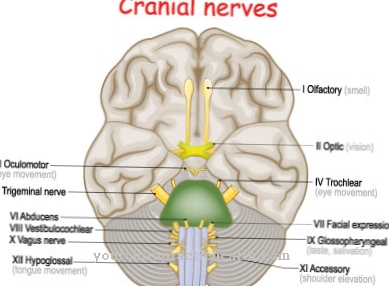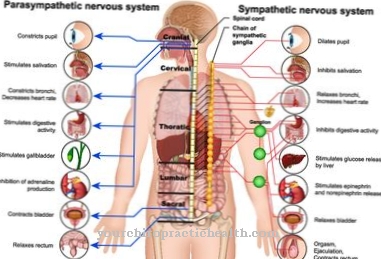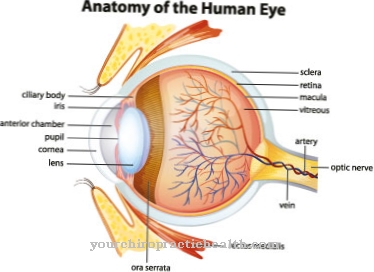A Lead poisoning (saturnism) When the toxic metal is absorbed, lead is produced. The human organism is damaged by the heavy metal lead.
What is lead poisoning?

© Henrie - stock.adobe.com
A distinction is made between acute and chronic lead poisoning. Acute lead poisoning does not occur until very large, one-time ingested amounts of lead or lead compounds. Fatal in adults z. B. a dose of 5 to 30 grams of the water-soluble lead salt lead acetate.
In contrast, the daily intake of 1 microgram z. B. through food only after a long time to chronic lead poisoning. The World Health Organization estimates that daily lead intake through the mouth averages around 100 to 500 milligrams.
Different organs of the human body are affected by lead poisoning. This includes both the peripheral and the central nervous system, the bone marrow, which is also largely responsible for blood formation, the gastrointestinal area, the gonads, the skin and the kidneys.
causes
Today, lead poisoning is primarily a result of accidents at work or the consumption of contaminated drugs, while lead poisoning often occurred in the past due to objects containing lead such as water pipes, cans or dishes.
Lead poisoning occurs particularly when inhaling lead-containing vapors or dusts, e.g. B. when processing lead-containing paints. But lead can also get into the body through skin contact or through food. So z. B. lead-containing ointments used in beauty care cause lead poisoning. Chronic lead poisoning in adults occurs when a lead quantity of approximately 500 nanograms is added.
95% of the lead that gets into the blood binds to the erythrocytes (red blood cells) and to blood proteins. The lead then reaches organs such as the brain, liver and lungs via the bloodstream, where it has a half-life of 20 days.
While some of the lead is excreted, some of it is also deposited in teeth and bones. There the half-life is 5 to 20 years. If the bone substance is broken down to a large extent, the lead level in the blood can rise even without a new supply from outside the body.
Because lead also penetrates the placenta, lead poisoning can be transmitted from the mother to the unborn child.
Symptoms, ailments & signs
Chronic or acute poisoning occurs depending on the strength and duration of the lead exposure. Acute lead poisoning is characterized by headache and body aches, severe abdominal cramps and fatigue. In severe cases, it can also lead to coma and circulatory failure with fatal consequences. A spastic ileus (bowel obstruction) is also possible.
Acute lead poisoning can be treated with gastric lavage. However, chronic lead poisoning is more insidious. Long-term contamination with lead can lead to various symptoms. Since the heavy metal has an inhibitory effect on blood formation, so-called lead anemia develops in the event of chronic lead poisoning.
Like all forms of anemia, this leads to fatigue and reduced physical and mental performance. A bluish-gray to black-gray coating of lead sulfide is deposited on the gums. The cardiovascular system is compromised because of the vasodilating hormones released by lead. Cardiac arrhythmias, heart failure and heart attacks can occur.
Furthermore, symptoms such as disorientation, headaches, aggressiveness, overactivity, insomnia or apathy occur due to the damage to the nervous system and the brain. Severe cases of nerve damage are characterized by delirium, coma or convulsions, which can lead to death from circulatory failure. Furthermore, numbness and sensitivity disorders in the extremities as well as motor failures are possible. After all, if the lead concentration in the blood exceeds a certain level, kidney damage can occur in the long term.
Diagnosis & course
Symptoms of acute lead poisoning, which is rather rare, are insomnia, dizziness, headaches, abdominal pain and seizures, a slowdown in movement sequences and delirium-like conditions, despite severe fatigue. Brain damage (lead encephalopathy) occurs especially in children who suffer lead poisoning. Acute lead poisoning is severe poisoning that can lead to coma and, due to circulatory failure, death.
Chronic lead poisoning includes loss of appetite, fatigue, headache, abdominal pain, and constipation. The patient's skin appears grayish-yellowish, while the edge of the gums is darkly discolored with a so-called lead border. Lead makes the formation of red blood more difficult, so that anemia (lead anemia) occurs. It can also lead to severe kidney damage.
A nerve disease due to lead poisoning (polyneuropathy) regularly paralyzes the extensor muscles in the arms, leads to hearing loss and ringing in the ears. In children in particular, lead poisoning can cause brain damage.
The best way to diagnose lead poisoning is with a blood test, but it can also be done by analyzing urine, hair, or teeth.In the urine, however, the lead can be irregularly distributed due to the fact that the body does not use fluids evenly, so that measurement inaccuracies cannot be ruled out in the case of lead poisoning.
Complications
Lead poisoning usually leads directly to tiredness, nausea and vomiting. In the longer term, improper treatment of the poisoning can cause further complications. In children, even a small amount of lead can cause permanent physical and mental damage. The greatest complications are developmental disorders, hearing problems, coordination and concentration difficulties.
In addition, behavior problems such as aggressiveness and hyperactivity can occur. Typical physical complications of lead poisoning include kidney damage and lung disease. Lead poisoning can rarely lead to life-threatening sepsis with serious consequences. With larger amounts of lead there is also the risk of kidney failure, which can also be fatal if left untreated.
Chronic lead poisoning reduces general well-being and is associated with loss of appetite, fatigue, headache and abdominal pain, and constipation. Because lead reduces the formation of red blood cells, the risk of anemia also increases. Permanent kidney damage and other complications can also arise.
The extent of the complaints essentially depends on the amount of lead consumed and the constitution of the person concerned; Rapid treatment significantly reduces the risk of permanent damage and usually leads to a complete recovery of the patient.
When should you go to the doctor?
Acute lead poisoning is a potentially life-threatening disorder that must not be underestimated or played down. Medical help must be sought if large amounts of the toxin are ingested. 30 grams of lead are acutely life-threatening, but for many people a significantly smaller amount is lethal.
Large amounts of lead are generally only absorbed in the event of an accident at work. Those affected can recognize lead poisoning by a number of characteristic symptoms. Typical are, for example, the loss of the sense of taste and severe bulging pain, which can radiate into the upper body regions. Anyone who works in a company that processes lead or substances containing lead should consult a doctor immediately if these symptoms occur. If there are additional complaints such as dizziness, seizures and impaired coordination, the emergency doctor must be called without hesitation.
Chronic lead poisoning should also be treated more medically. However, they are more difficult to identify for those affected. The suspicion of chronic lead poisoning should be clarified by a doctor if a person feels constantly stressed for no apparent reason, complains of diffuse headaches and abdominal pain and shows signs of anemia. Typical symptoms are also yellowish discoloration of the skin and the so-called lead border, a blue-black discoloration of the gums. Anyone who observes such symptoms should see a doctor immediately.
Doctors & therapists in your area
Treatment & Therapy
Treatment for lead poisoning depends on the type of lead ingestion and the duration of the poisoning. When lead is absorbed through the mouth, attempts are made to remove the heavy metal as much as possible from the body by vomiting or by gastric lavage. In acute lead poisoning, the fluid used for gastric lavage consists of a three percent sodium sulfate solution. At the same time activated charcoal is administered, whereby the lead components - converted into less soluble lead sulphate - are bound to the activated charcoal.
If the lead has already entered the body through the stomach, the patient is given drugs such as B. administered penicillamine, which binds the lead in his body and thus render it harmless so that the heavy metal can be excreted via the kidneys. At this point in time, the blood ideally makes it possible to check whether the therapy is working as desired.
Antispasmodic preparations (spasmolytics) are used against abdominal pain. If kidney damage has occurred, blood washing may be necessary temporarily or even permanently. The sick person must absolutely avoid any further contact with the heavy metal lead. To do this, however, it is necessary to clearly identify the source of lead poisoning.
Outlook & forecast
The prognosis for lead poisoning depends on the amount of lead in the body and the duration of exposure. The earlier lead poisoning is identified and treated, the better the prognosis. Mild cases of acute lead poisoning have a particularly good prognosis.
Acute lead poisoning affects younger children more severely than adults. In children, for example, brain damage can occur in addition to colic, which makes their prognosis less favorable and requires even faster action.
Chronic lead poisoning will result in death over time if left untreated. Nerve and kidney damage in particular play a role here, as they ultimately make those affected unable to live. Nevertheless, even severe cases of chronic lead intoxication can be treated with complexing agents and chelation therapy. However, damage to organs that has already occurred on a structural level cannot be reversed, so that those affected will continue to live with restrictions after therapy.
Chronic lead intoxication can also occur again and again in those affected and lead to symptoms if the source of the damage is not found.
prevention
Lead poisoning can primarily be achieved by avoiding the release of lead. The use of many materials containing lead has been restricted or prohibited. Waste containing lead (e.g. in old car batteries) is disposed of separately. Existing lead-containing water pipes, which can contaminate drinking water to a considerable extent with lead, should be replaced. Pregnant women and small children in particular must avoid drinking water containing lead.
Aftercare
Follow-up care is of great importance in the case of lead poisoning, especially if it is a serious case of poisoning and secondary diseases have occurred. Severe lead poisoning can damage the brain and impair cognitive abilities. In this case, it is important that patients train their cognitive skills regularly in order to keep long-term damage as low as possible.
In particular, a reduction in memory performance caused by lead poisoning and severe concentration disorders can be alleviated through targeted exercises. In children there are often psychological abnormalities, especially increased aggressiveness or the exact opposite, listlessness and lethargy or frequent crying fits. This behavior can be counteracted by targeted educational measures.
Physiotherapeutic support and treatment of damage to muscles and joints is also important. Here too, regular, targeted exercises can significantly improve the performance of the affected muscles and joints. Pregnant women should be informed about possible damage to the embryo and the increased risk of stillbirth.
In patients in whom the gastrointestinal tract in particular has been damaged, light diets and possibly a general change in diet may be necessary over a longer period of time. Lead poisoning can also lead to damage to the gums, which often only occurs with a delay, which is why adequate dental care should be ensured. Because of the increased risk of cancer, patients should also be made aware of the importance of preventive medical examinations.
You can do that yourself
If lead poisoning is suspected, the first route is to see a doctor. Once the poisoning is diagnosed, some home remedies and self-measures can aid recovery.
First of all, drink a lot and regularly to flush out the lead. Sports activities and regular saunas encourage perspiration and thus also the flushing out of the harmful substance. Various natural remedies such as Schüssler's salts or the chlorella algae achieve a similar effect. In order for the detoxification to succeed without complications, the internal organs such as the liver, kidneys, intestines and lungs should be strengthened. Here, too, physical exercise is recommended as a supplement to a healthy and balanced diet.
If the lead poisoning has already caused psychological damage, this must be treated with various therapeutic measures. As additional personal measures, relaxation exercises, discussions with friends and family members and sometimes a change of environment are recommended. Before doing this, however, the cause of the lead poisoning must be determined and eliminated. This is possible, for example, by moving (e.g. with lead in the color of the wall) or by changing jobs. Corresponding steps should always be discussed with the responsible doctor first.






.jpg)




















